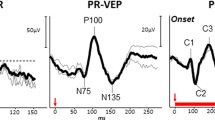Abstract
This study reports the pattern visual evoked potential (PVEP) findings in 10 patients with idiopathic hypothyroidism. Eight of these patients also had pattern electroretinography (PERG) performed and six were additionally seen after treatment with thyroxine.
Only one patient had definitely abnormal PVEPs at the time of initial recording. PERGs at this time were of abnormal latency and subnormal amplitude. Following treatment with thyroxine the patient became euthyroid. Repeat electrodiagnostic testing now showed both PERGs and PVEPs within the normal range, having markedly improved in both latency and amplitude. This suggests that the PVEP delay was probably secondary to reversible central retinal dysfunction.
Similar content being viewed by others
References
Mastaglia FL, Black JL, Collins DWK, Gutteridge DH, Yuen RWM. Slowing of conduction in visual pathway in hypothyroidism. Lancet 1978; 1: 387–8.
Abbott RJ, O'Malley BP, Barnett DB, Timson L, Rosenthal FD. Central and peripheral nerve conduction in thyroid dysfunction: the influence of L-thyroxine therapy compared with warming upon the conduction abnormalities of primary hypothyroidism. Clin Sci 1983; 64: 617–22.
Ladenson PW, Stakes JW, Ridgway EC. Reversible alteration of the visual evoked potential in hypothyroidism. Am J Med 1984; 77: 1010–14.
Holder GE. The effects of chiasmal compression on the pattern visual evoked potential. Electroencephalogr Clin Neurophysiol 1978; 45: 278–80.
Holder GE, Chesterton JR. The visual evoked potential in Harada's disease. Neuroophthalmology 1984; 4: 43–5.
Holder GE. Significance of abnormal pattern electroretinography in anterior visual pathway dysfunction. Br J Ophthalmol 1987; 71: 166–71.
Holder GE Abnormalities of the pattern ERG in optic nerve lesions: changes specific for proximal retinal dysfunction. In: Barber C, Blum T, eds. Evoked Potentials III. London: Butterworths, 1987: 211–224.
Bass SJ, Sherman J, Bodis-Wollner I, Nath S. Visual evoked potentials in macular disease. Invest Ophthalmol Vis Sci 1985; 26: 1071–4.
Celesia GG, Kaufman D. Pattern ERGs and visual evoked potentials in maculopathies and optic nerve diseases. Invest Ophthalmol Vis Sci 1985; 26: 726–35.
Holder GE. Delayed pattern VEP: retinal or optic nerve disease? Electroencephalogr Clin Neurophysiol 1988; 69: 72–73P.
Pearlman JT, Burian HM. Electroretinographic findings in thyroid dysfunction. Am J Ophthalmol 1964; 58: 216–26.
Author information
Authors and Affiliations
Rights and permissions
About this article
Cite this article
Holder, G.E., Condon, J.R. Pattern visual evoked potentials and pattern electroretinograms in hypothyroidism. Doc Ophthalmol 73, 127–131 (1989). https://doi.org/10.1007/BF00155030
Accepted:
Issue Date:
DOI: https://doi.org/10.1007/BF00155030




